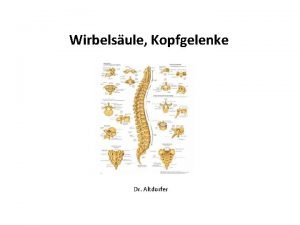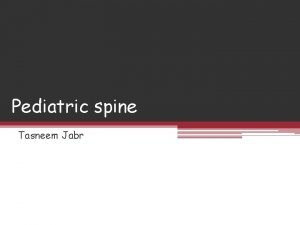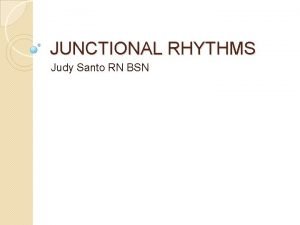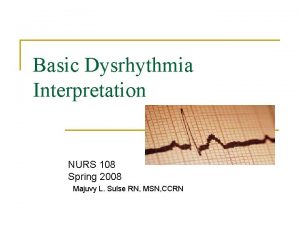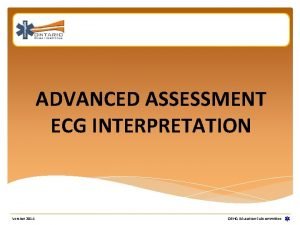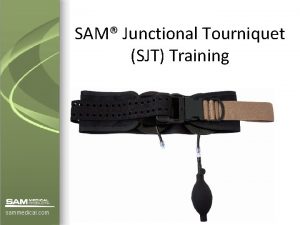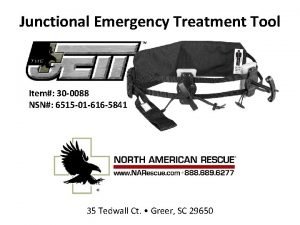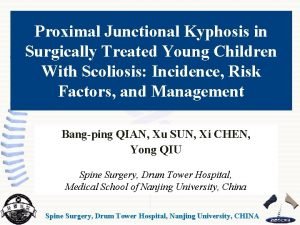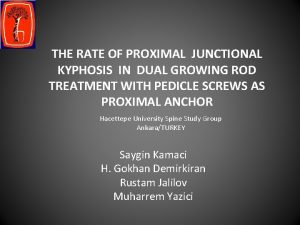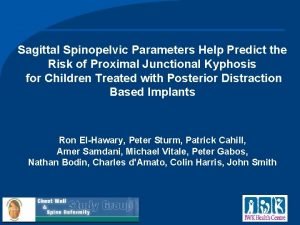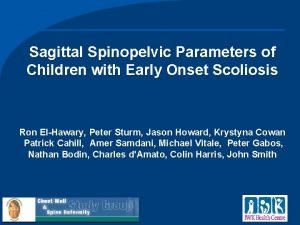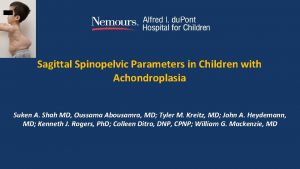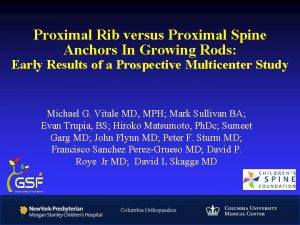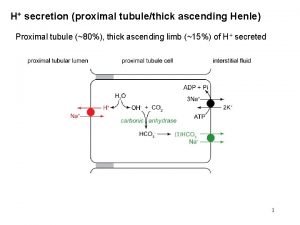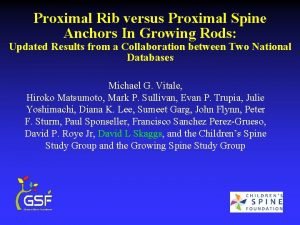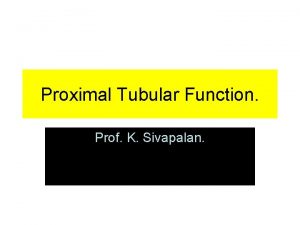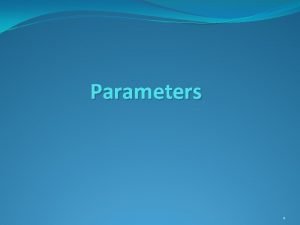Spinopelvic Parameters Predict Development of Proximal Junctional Kyphosis

















- Slides: 17

Spinopelvic Parameters Predict Development of Proximal Junctional Kyphosis in Early Onset Scoliosis Ozren Kubat, Virginie Lafage, Jennifer Hurry, Alexandra Soroceanu, Frank Schwab, David L. Skaggs, Ron El-Hawary Children's Spine and Growing Spine Study Groups

Background Proximal Junctional Kyphosis (PJK) is diagnosed: ◦ Radiographically using the proximal junctional angle (PJA). ◦ Clinically, with the requirement for proximal extension of the upper instrumented vertebrae (UIV) during revision surgery.

Background Early Onset Scoliosis (n=40) 28% Risk of PJK with minimum 2 yr follow-up Relative Risk 2. 8 for Pre-op hyperkyphosis Relative Risk 3. 1 for High Pelvic Incidence Children Spine Study Group, JPO 2015

Background High PI has been found to increase risk of PJK in Adult Scoliosis. Other spinopelvic parameters have been found to predict post-op complications and HRQOL in Adult Scoliosis Schwab et al. , Spine 2012

Purpose To determine if abnormal spinopelvic alignment will increase the risk of developing PJK in children with Early Onset Scoliosis.

Study Design Retrospective cohort study of children treated with distraction based implants from 2 Early Onset Scoliosis registries (minimum 2 year follow up).

Analysis Sagittal radiographs were analyzed to measure: ◦ Spinopelvic parameters ◦ PJA (angle between caudal endplate of the Upper Instrumented Vertebrae (UIV) to the cephalad endplate 2 vertebrae above UIV). Risk ratios were calculated analyzed using chi squared testing.

Results 135 children with EOS with > 2 yr f/u ◦ 89 Rib-Based and 46 Spine-Based Distraction Etiologies: ◦ ◦ ◦ 54 congenital 10 neuromuscular 37 syndromic 32 idiopathic 2 unknown

Results Pre-op Age 2 Yr Post-op 5. 2 years Scoliosis 71 o 56 o Thoracic Kyphosis 39 o 42 o Lumbar Lordosis 52 o 55 o Pelvic Tilt 11 o 13 o Sacral Slope 38 o 39 o Pelvic Incidence 49 o 52 o

Results: Pre-Op Factors Radiographic PJK: Final PJA>10 o Relative Risk Significance Thoracic Kyphosis > 50 o 1. 67 (0. 98 -2. 8) P<0. 05, CI Lumbar Lordosis >70 o 0. 96 NS Pelvic Tilt >30 o 0. 65 NS Pelvic Incidence >60 o 1. 02 NS

Results: Pre-Op Factors Clinical PJK: Revision with proximal extension Relative Risk Significance Thoracic Kyphosis > 50 o 0. 95 NS Lumbar Lordosis >70 o 0. 72 NS Pelvic Tilt >30 o 0. 73 NS Pelvic Incidence >60 o 0. 82 NS

Results: Post-Op Factors Radiographic PJK: Final PJA>10 o Relative Risk Significance Rib vs. Spine Based 0. 58 (0. 350. 96) P<0. 05 Pelvic Tilt >30 o 1. 54 NS PI – LL >20 o 1. 54 NS 36 children had Final PJA>10 o (38% Risk). ◦ 31% Rib-Based vs. 54% Spine-Based (p<0. 05)

Results: Post-Op Factors Clinical PJK: Revision with proximal extension Relative Risk Significance Rib vs. Spine Based 0. 86 (0. 4 -1. 8) NS Pelvic Tilt >30 o 2. 5 (1. 1 -5. 5) P<0. 05 PI – LL >20 o 2. 1 (0. 9 -4. 8) P<0. 05, CI 24 children required revision surgery with proximal extension of UIV (18% Risk). ◦ 17% Rib vs. 20% Spine-Based (NS)

Conclusions Radiographic PJK ◦ There was a 38% risk of developing radiographic PJK ◦ There was a significantly higher risk for spinebased (54%) vs. rib-based (31%) patients. Clinical PJK ◦ There was an 18% risk of developing clinical PJK. ◦ There was not a significant difference in risk between spine-based and rib-based patients.

Conclusions For patients undergoing growth-friendly surgery, pre-operative hyperkyphosis increased the risk for developing postoperative radiographic PJK. Final post-operative PI-LL>20 o and final post -operative PT>30 o were each associated with increased risk for clinical PJK.

References Mac-Thiong JM, Labelle H, Berthonnaud E, et al. Sagittal spinopelvic balance in normal children and adolescents. Eur Spine J. 2007; 16: 227– 234. Schwab F, Ungar B, Blondel B, et al. Scoliosis research society-schwab adult spinal deformity classification: a validation study. Spine (Phila Pa 1976). 2012; 37(12): 10771082. El-Hawary R, Sturm PF, Cahill PJ, Samdani AF, Vitale MG, Gabos PG, Bodin ND, d'Amato CR, Harris C, Smith J. Sagittal Spinopelvic Parameters Help Predict the Risk of Proximal Junctional Kyphosis for Children Treated with Posterior Distraction Based Implants. J Pediatr Orthop. 2015 Jul 17. El-Hawary R, Sturm PF, Cahill PJ, Samdani AF, Vitale MG, Gabos PG, Bodin ND, d'Amato CR, Harris C, Howard J, Morris S, Smith J. Sagittal Spinopelvic Parameters of Young Children with Scoliosis. Spine Deformity 2013; 1(5), 343 -347.

Thank You
 Thoracic kyphosis
Thoracic kyphosis Piccolo assessment
Piccolo assessment Art. atlantoaxialis
Art. atlantoaxialis Adams forward bend test
Adams forward bend test Kyphosis
Kyphosis Vygotsky zone of proximal development
Vygotsky zone of proximal development Jean piaget zone of proximal development
Jean piaget zone of proximal development Zpd examples
Zpd examples Zone of proximal development
Zone of proximal development Junctional rhythm characteristics
Junctional rhythm characteristics Junctional rhythm
Junctional rhythm Dentoperiosteal fibers
Dentoperiosteal fibers Unifocal pvc
Unifocal pvc Normal sinus rhythm with pjc
Normal sinus rhythm with pjc Apakah junctional complex yang paling rapat?
Apakah junctional complex yang paling rapat? Junctional emergency treatment tool
Junctional emergency treatment tool Sam junctional tourniquet axillary
Sam junctional tourniquet axillary Paso 3
Paso 3


